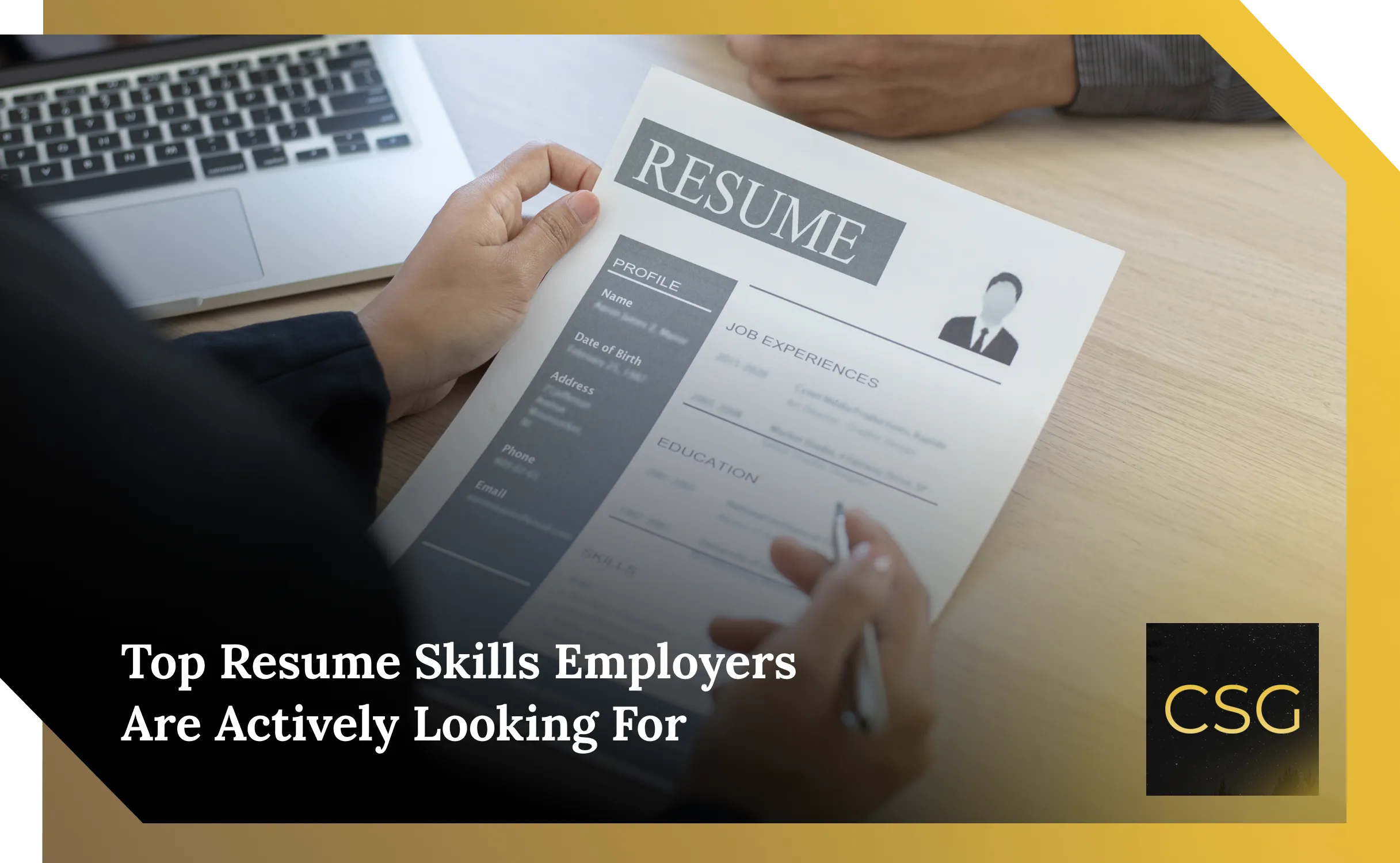In a hiring landscape that’s more competitive and fast-paced than ever, your resume has mere seconds to make an impression. And guess what recruiters scan first? Your skills. But not just any skills, they want proof, context, and relevance.
So, what exactly are the best skills in a resume in 2025? And more importantly, how do you present them in a way that resonates with employers?
This guide dives deep into:
- Why resume skills are more critical than ever
- The most in-demand hard and soft skills in today’s U.S. job market
- Real examples, expert advice, and formatting tips to help you stand out
Let’s turn your resume into a skills-first powerhouse.
Summary
- In 2025, skills drive hiring decisions, with 75% of recruiters prioritizing proven abilities over job titles. Employers expect proof and measurable impact, not just keywords.
- Top hard skills include data analysis, AI tools, cloud computing, cybersecurity, SEO, and Agile project management. Leading soft skills are emotional intelligence, communication, problem-solving, and time management shown through outcomes, not claims.
- To stand out, create a Core Skills section near the top of your resume and weave skills into work experience using the formula: Skill + Tool + Outcome. Tailor every application to match job-specific keywords, highlight transferable skills when switching careers, and showcase relevant AI or niche platforms.
- In short: context, proof, and relevance are the winning formula for resume skills in 2025.
Why Resume Skills Matter More Than Ever
Skills Speak Before You Do
According to a 2024 LinkedIn Hiring Report, 75% of recruiters prioritize a candidate’s skill set over previous job titles. In fact, many hiring platforms and applicant tracking systems (ATS) rank candidates based on skills match before a human even reads your resume.
The Rise of Skills-Based Hiring
The pandemic accelerated a trend toward skills-first recruitment. Employers across industries are more open to hiring candidates based on what they can do, not just where they worked. This shift especially favors applicants from non-traditional paths, career switchers, and self-taught professionals.
What Employers Really Want: Context, Not Just Keywords
Simply listing “Leadership” or “Time Management” isn’t enough. Recruiters want to know:
- Where did you apply the skill?
- How did it benefit the team, company, or project?
- What tools or frameworks did you use?
Make It Measurable
- Wrong: Strong project management skills.
Right: Managed a cross-functional team of 8, delivering a SaaS rollout two weeks ahead of schedule using Agile methodology.
The difference? Tangible results. This approach not only proves you have the skill but shows how effectively you use it.
Top Hard Skills to Include in Your Resume (2025)
Hard skills are teachable, measurable, and job-specific. Based on industry hiring data, here are the most in-demand:
1. Digital & Tech Skills
- Data analysis (Excel, Python, SQL, Tableau)
- AI & automation tools (ChatGPT, Zapier, Notion AI)
- Web development (HTML, JavaScript, React)
- Cloud computing (AWS, Azure, Google Cloud)
- Cybersecurity compliance
2. Marketing & Communication
- SEO/SEM
- Email automation (Mailchimp, HubSpot)
- Social media analytics
- Google Ads/Analytics
- Video editing (Final Cut Pro, Canva)
3. Project & Business Management
- Agile & Scrum frameworks
- Project tools (Asana, Jira, Trello)
- Budget forecasting
- Business intelligence (Power BI, Looker)
Pro Tip: Match your hard skills exactly to the job posting to improve ATS visibility.
Top Soft Skills That Employers Notice (And How to Show Them)
Soft skills often differentiate top candidates, especially in remote and hybrid work settings. Here are the must-haves:
1. Emotional Intelligence & Communication
Showcase your ability to collaborate, resolve conflict, and communicate across channels.
Example: Facilitated weekly virtual syncs that improved cross-team communication, reducing misalignment issues by 40%.
2. Critical Thinking & Problem-Solving
Demonstrate how you address challenges and make decisions under pressure.
Example: Resolved a workflow bottleneck by redesigning a customer intake process, cutting average response time from 48 to 12 hours.
3. Time Management & Accountability
Especially in self-managed or remote roles, this is crucial.
Example: Balanced priorities across four client accounts, consistently meeting monthly KPIs.
Skills by Industry: What Recruiters Are Really Prioritizing
Recruiters at Constellation Search report industry-specific patterns in skills demand:
Technology & IT
- Cloud platforms, APIs, version control (Git)
- Cybersecurity & network architecture
Healthcare
- EMR software (Epic, Cerner)
- HIPAA compliance
- Patient communication
Finance & Accounting
- GAAP knowledge
- Budget analysis
- ERP tools (NetSuite, QuickBooks, SAP)
Marketing & Sales
- Funnel optimization
- Copywriting & UX principles
- CRM platforms (Salesforce, Zoho)
How to Format and Highlight Skills on Your Resume
1. Create a “Core Competencies” Section
Place it near the top to ensure visibility. Use bullet points, not paragraphs.
Example:
Core Skills:
- Agile Project Management
- Budget Forecasting
- Google Analytics & SEO
- Conflict Resolution
2. Weave Skills into Your Work Experience
Use the formula: Skill + Tool + Outcome.
Example: Led SEO strategy using Semrush and Google Search Console, resulting in a 35% traffic increase.
3. Tailor Every Time
Customizing your resume for each application increases response rates by 34% (Jobscan).
Resume Skills: Before & After Transformation
Before: Customer service, CRM, problem-solving
After: Resolved 25+ customer queries daily via Zendesk with a 97% satisfaction rate; implemented ticket triaging to reduce resolution time by 30%.
FAQs About Resume Skills
Q. How many skills should I list?
Aim for 8–12 focused, high-impact skills. Too few may undersell your capabilities, while too many can overwhelm or dilute your message. Prioritize skills that are most relevant to the role you’re applying for, and tailor them to match keywords in the job description. A concise, targeted list shows both breadth and depth without looking unfocused.
Q. Where should skills go on the resume?
Include a “Core Skills” or “Key Competencies” section near the top for quick visibility. You should also weave relevant skills into your work experience bullets, where you can show how you applied them to deliver results. This balance of listing and demonstrating ensures that recruiters and applicant tracking systems (ATS) both recognize your expertise.
Q. What if I’m switching careers?
Highlight transferable skills such as communication, leadership, problem-solving, or project management, and then connect them to your target field. Supporting them with quantifiable results, coursework, certifications, or volunteer projects can make them more credible. Tailor your language so the skills feel industry-specific rather than generic. This approach shows employers you can adapt and add value quickly.
Q. Can I include AI tools or niche platforms?
Yes — but only if they’re relevant to the job. Listing AI tools, specialized software, or niche platforms signals technical adaptability, which many employers value. However, avoid padding your resume with tools that are outdated, too basic (like “Microsoft Word”), or unrelated to the role. Emphasize tools that set you apart and align with the job’s requirements.
Skills Hiring Trends in 2025
According to SHRM and LinkedIn data:
- 89% of employers value problem-solving and adaptability.
- 75% of resumes are filtered by ATS before human review.
- 65% of U.S. companies report a widening digital skills gap.
Action Checklist: Update Your Resume Like a Pro
- Remove generic, unsupported skill claims
- Replace with proof-based skill outcomes
- Add a “Core Skills” section up top
- Tailor to each job ad’s keywords
- Test for ATS with tools like Jobscan
Employers want to know what you can do — and how well you do it. By emphasizing skills with context, proof, and alignment to the job, you’ll not only pass the ATS gatekeeper, but impress hiring managers too.
Update your resume today with the skills that matter. Your next opportunity might be just one well-worded bullet point away.






